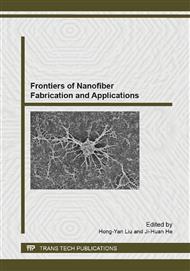[1]
D. Chen, T.X. Liu, X.P. Zhou, W.C. Tjiu, H.Q. Hou. Electrospinning Fabrication of High Strength and Toughness Polyimide Nanofiber Membranes Containing Multiwalled Carbon Nanotubes, J. Phys. Chem. 29 (2009) 9741-9748.
DOI: 10.1021/jp9025128
Google Scholar
[2]
P.P. Tsai, J.R. Roth, W.W. Chen. Strength, Surface Energy, and Ageing of Meltblown and Electrospun Nylon and Polyurethane (PU) Fabrics Treated by a One Atmosphere Uniform Glow Discharge Plasma (OAUGDP™), Text Res J. 12 (2005) 819-825.
DOI: 10.1177/0040517505057526
Google Scholar
[3]
J.P. Tessonnier, L. Pesant, C. Pham-Huu, G. Ehret, M.J. Ledoux. Carbon nanotubes: a highly selective support for the C=C hydrogenation reaction, Stud. Surf. Sci. Catal. 143(2002) 697-704.
DOI: 10.1016/s0167-2991(00)80712-0
Google Scholar
[4]
Q. Ngo, B.A. Cruden, A.M. Cassell, G. Sims, M. Meyyappan, J. Li, C. Y. Yang. Thermal Interface Properties of Cu-filled Vertically Aligned Carbon Nanofiber Arrays, Nano Lett. 12 (2004) 2403-2407.
DOI: 10.1021/nl048506t
Google Scholar
[5]
L.X. He, S.C. Tjong. Nonlinear electrical conduction in percolating systems induced by internal field emission, J. Nanosci. Nanotechno.5 (2011) 3916-3921.
DOI: 10.1016/j.synthmet.2010.12.007
Google Scholar
[6]
P. Gibson, H. Schreuder-Gibson, D. Rivin. Transport properties of porous membranes based on electrospun nanofibers, Colloid Surface A. 187 (2001) 469-481.
DOI: 10.1016/s0927-7757(01)00616-1
Google Scholar
[7]
A. Formalhals, inventor; no assignee; US Patent 1,975,504, 1934.
Google Scholar
[8]
J.H. He, Effect of temperature on surface tension of a bubble and hierarchical ruptured bubbles for nanofiber fabrication, Therm. Sci., 16 (2012) 327-330.
DOI: 10.2298/tsci111111033h
Google Scholar
[9]
J.H. He, Y. Liu, Control of bubble size and bubble number in bubble electrospinning, Comput. Math. Appl., 64 (2012) 1033-1035.
DOI: 10.1016/j.camwa.2012.03.021
Google Scholar
[10]
J.H. He. The Smaller, the Better: From the Spider-Spinning to Bubble-Electrospinning, Acta Physica Polonica A. 121 (2012) 254-256
DOI: 10.12693/aphyspola.121.254
Google Scholar
[11]
M. Sangmanee, S. Maensiri. Nanostructures and magnetic properties of cobalt ferrite (CoFe2O4) fabricated by electrospinning, Appl. Phys. A: Mater. Sci. Process. 97 (2009) 167-177.
DOI: 10.1007/s00339-009-5256-5
Google Scholar
[12]
X.F. Wang, B. Ding, J.Y. Yu, Y. Si, S.B. Yang, G. Sun. Electro-netting: Fabrication of two-dimensional nano-nets for highly sensitive trimethylamine sensing, Nanosci. 3 (2011) 911-915.
DOI: 10.1039/c0nr00783h
Google Scholar
[13]
R.R. Yang, J.H. He, J.Y. Yu, L. Xu. Bubble-electrospinning for Fabrication of Nanofibers with Diameter of about 20nm, Int J Nonlinear Sci.11 (2010) 163-164.
DOI: 10.1515/ijnsns.2010.11.s1.163
Google Scholar
[14]
J.H. He, H.Y. Kong, R.R. Yang, et al., Review on fiber morphology obtained by the bubble electrospinning and Blown bubble spinning, Therm. Sci., 16 (2012), 1263-1279.
DOI: 10.2298/tsci1205263h
Google Scholar


